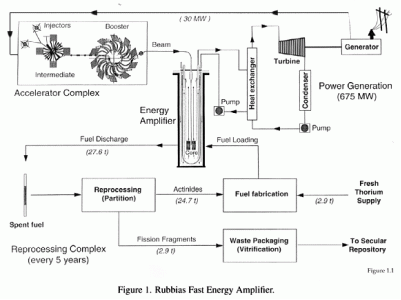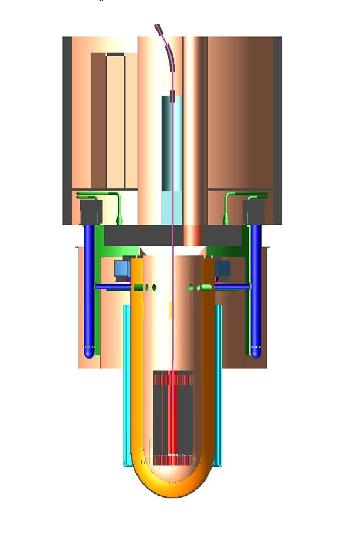Thorium: A Cheap, Clean and Safe Alternative to Uranium |
 |
 |
 |
Written by Brian Westenhaus |
| Tuesday, 14 September 2010 16:44 |
With some concept tests thorium used as a nuclear fuel could end energy as a problem issue and shift the economy into a new growth phase. All the conversation in the media, politics and the economy could be moved to building the next centuries energy production with thorium and the various ways to use the metal as a fission power source. Nobel laureate Carlo Rubbia at the European Organization for Nuclear Research points out the use of thorium as a cheap, clean and safe alternative to uranium in reactors may be the magic bullet we have all been hoping for. It’s an idea well worth much more attention. The math on thorium is impressive. Dr Rubbia says a metric ton of the silvery metal produces as much energy as 200 tons of uranium, or 3,500,000 ton of coal. A handful would power a major city for a week. Another thorium reactor opportunity is thorium consumes its own hazardous waste. It can even scavenge the plutonium left by uranium reactors, acting as an eco-cleaner. Kirk Sorensen, a former NASA rocket engineer, now chief nuclear technologist at Teledyne Brown Engineering, and closely watched Internet commentator and educator says, “It’s the Big One, once you start looking more closely, it blows your mind away. You can run civilization on thorium for hundreds of thousands of years, and it’s essentially free. You don’t have to deal with uranium cartels.” He’s right; thorium is so common that miners treat it as a nuisance, a radioactive by-product when they dig up rare earth metals. The U.S. and Australia are full of the stuff. So are the granite rocks of Cornwall in the UK. Some beaches in India are loaded with thorium. Not so much mining is needed: all thorium is potentially usable as fuel, compared to just 0.7% from uranium as much of the uranium has already decayed. U.S. scientists knew in the late 1940s that thorium was a high potential fuel, but weapons priorities pushed uranium and plutonium to the front. Yet by the early 1970s thorium research had produced a highly workable, safe and low cost reactor design that the U.S. put on the shelf. Uranium industry competition with thorium won the struggle for research and development funding. Europe’s Organization for Nuclear Research took a run at funding in 1999-2000 when CERN went to the European Commission and they were rebuffed. The EU used European experts from France, as the French industry is the largest in Europe. Professor Egil Lillestol, a world authority on the thorium fuel-cycle at CERN says, “They didn’t want competition because they had made a huge investment in the old technology.” It was the classic victory of vested interests over scientific progress. Thorium offers some other important aspects, it does not require isotope separation, the process of separating the desired reactable forms of uranium and plutonium from the decayed ore, a big cost saving. Weapons made from thorium are impractical. Meanwhile a great deal of thought and concept development has taken place. Dr. Rubia, who has a patent on a thorium fuel cycle has licensed to the Norwegian firm Aker Solutions, a part of the huge Aker Group. Aker is working on the patented design using a proton accelerator at its UK location.
Victoria Ashley, the Aker UK project manager, said it could lead to a network of pint-sized 600MW reactors that are lodged underground, can supply small grids, and do not require a huge concrete safety dome. It will take £2bn to build the first one, and Aker needs £100mn for the next test phase. Add Aker to the list of mini reactors at a giant 600MW rating.
So Aker is looking for joint venture deals with U.S., Russian, or Chinese firms. The Indians have their own projects – none yet built – dating from days when they switched to thorium because their weapons program prompted a uranium ban. In the U.S. research pioneers are exploring a truly radical shift to a liquid fuel based on molten-fluoride salts, an idea once pursued by US physicist Alvin Weinberg at Oak Ridge National Lab in Tennessee in the 1960s. The original documents were recovered by Mr. Sorensen. The matter today wallows in the U.S. administrations passive silence on research – a hint that loyalties are to the environmental pressure groups – even as thorium would solve those group’s primary objections and the entrenched interests. It’s eerily like the 1930s when researchers knew the Nazis were busily working on an atomic bomb, news that met simple disbelief. U.S. president Roosevelt needed more than a letter from Einstein, but a meeting shifted the minds such that Roosevelt started the Manhattan project. No other on Earth energy source exists at the volumes that thorium offers. Not uranium, oil, gas, coal or other fuel can compare. The assorted reactor designs all offer a weapon free design, some could use the spent uranium fuel on hand now and extract its energy as well as destroy the uranium’s potential as a weapon or a pollutant, safety concerns are reduced to decades instead of centuries, and the construction costs and operating expenses with a cheap fuel are intensely motivating to power producers and ratepayers. The issue isn’t about the science, thorium reactors have already ran successfully, its people who have to become informed and apply the pressure needed to overcome the special interests in the political arena where the regulatory barrier has the potential of thorium corralled and stopped. It’s your planet, economy and family – can we all stay uninformed, silent and bleeding our financial resources for the benefit of the special interests only because we don’t know? Nope – now you know. By Brian Westenhaus Source: A Thorium Overview Update This article originally published at: http://oilprice.com/Energy/Energy-General/Thorium-A-Cheap-Clean-and-Safe-Alternative-to-Uranium.html |
© 2010 OilPrice.com

